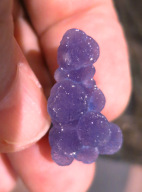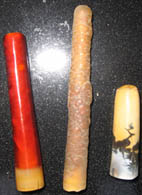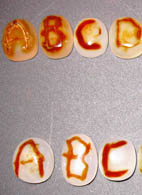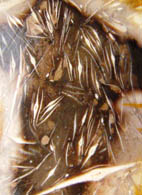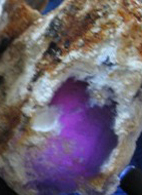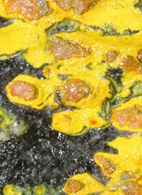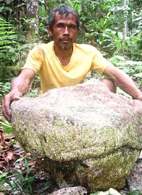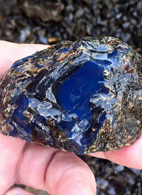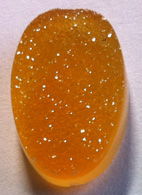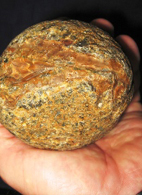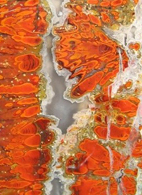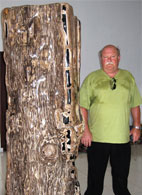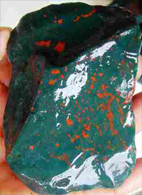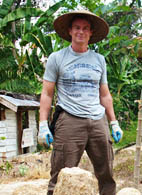In early 2009, clusters of agate tubes were recovered from a remote mountainside in Central Java.

Figure #1 - Central Java Volcanoes

Photo #1 - Mount Merapi Central Java
According to local folklore, the clumps of finger-like agate tubes form in the earth and villagers think if they bury the broken fingers in the ground, they will grow and broken ends will heal. They attribute the shapes to a local bamboo species they call “Awi” or stumpy Japanese Bambu (spelled “bambu” in Indonesian). They call the agate material “Fossil Bambu”.
It took several days to actually find the area (Photo #2).

Photo #2 - Home of “Fossil Bambu”
Mountain villagers are somewhat leery of outsiders and protective of their resources (Photo #3). Once we introduced ourselves and offered some geological perspective on their find, and possible ways to market the material, they were keen to share their theories and show us around.

Photo #3 - Defenders of “Fossil Bambu”
Originally, three 100+ kilogram clusters had washed out into a creek at the bottom of a steep slope (Photo #4).

Photo #4 - Massive Finger Agate Clusters
The material was part of a large landslide block composed of earth and volcanic rocks. The multicolored fingers attracted villager’s attention. They suspected the rocks had value but they had no experience with mining or prospecting. The villagers collected the broken bits and buried them in the soil in their back yards.
Thinking these must be some sorts of dripstone formed in a cave environment, we expected to find some sediments, solution cavities, limestone, lava tubes or some type of geological formation in which stalactites and stalagmites typically form. We struck out, finding only a thick pile of andesite volcanic flows, tuffs and land slide debris.
The locals who forage these slopes have since found small scattered occurrences of finger agate clusters across the slope and on both sides of the mountain. The villagers’ mysterious “Fossil Bambu” has become a routine part of their mountain harvest. They prod the loose soils in landslide areas using long steel rods as prospecting tools.
Material collected over the last year varies greatly in color and character. The large basal masses (Photo #5) consist of hollow tubes several centimeters in diameter with a consistent striated inner wall structure, suggesting that the agate formed around something organic, which subsequently decomposed away.

Photo #5 - Basal Mass of Agate Tubes
The fingers vary in size and thickness. We have seen individual fingers up to 30cm long and 5cm diameter (Photo #6). Grooves and striations along the inner walls suggest a cast or mold (Photo #7). Some pieces have a desiccated brown to black wood-like material inside (Photo #8).

Photo #6 - Agate Fingers

Photo #7 - Finger Agate Cross Section

Photo #8 - Guts of Finger Agates
Some spherical ping pong ball sized hollow molds were found attached to tangled fingers. The thin agate shell appeared to be mold left by some kind of fruit or bulb (Photo #9), while other fingers were curved, twisted or bent (Photo #10).

Photo #9 - Bulbous Fruit-like Cast

Photo #10 - Crooked Finger
Colors vary from blue, purple, and pink to orange, red, yellow and white (Photo #11). Colorful patterns such as orbs, bands, streaks and dendrites are common but often restricted to specific layers of the agate.

Photo #11 - Multicolor Bulbous Finger
Since discovery, I have seen a few tons of the material and collected specimens ranging in size from a few grams to 123kg (Photo #12). So far the deposit appears small, scattered and discovery of new material is hit & miss.

Photo #12 - Collecting “Fossil Bambu” Specimens
Paleobotanist William Walton Wright (“Walt”) came to visit for the month of November 2010. Walt has extensive experience identifying fossil plant materials from around the globe. Walt has conducted field visits to localities of fossiliferous rock formations on most continents and routinely hosts seminars on identification of fossil plant materials across the USA and informally around the World (Photo #13).

Photo #13 - Walt holds another International Seminar
We visited several collections of the “fossil bambu” material. There are no lab studies or analysis but with an abundance of samples in hand, we knocked around the possibilities for physical environment, geological settings and chemistry of formation.
As a geologist, I can comment on the likely geological environment of formation but Walt can recant the process step by step of transition from living plant to stone. According to Walt, there are numerous marsh or wetland plants from grasses, tules, sages, rushes and scouring-rushes, (equisetum) which have strong silica rich stems. When a volcano erupts, a deluge of siliceous volcanic ash falls into a marsh or on a hillside and later is washed into a wetland. The ash will undergo weathering oxidation, releasing abundant silica, iron, manganese and other ions into the water. Water chemistry becomes acidic and colloidal suspension of clays from the decomposing feldspars increases.
The tough stems of these marsh plants can become the nucleus for deposition of botryoidal crystallization of cryptocrystalline quartz (agate). Rains and dry weather cause the marsh waters to rise and fall and the acidity to vary. Repeated eruptions and ash deposition can result in layer upon layer of agate crystallization around the stems and other marsh bottom debris.
Subsequent death and decay of the plants occurs over the years. Some of the stems remain standing while others may bend. Some stems may break and fall to the marsh floor. Stems are left hollow as the organic components of the plants decompose. Suspended iron and manganese, clays and other elements become deposited in the hollow cores in a combination of “bog iron” residue which over time alters to become an infill of siderite surrounded by the cast of concentric rings of agate which Indonesians now call “Fossil Bambu”.
It just so happens the local common name for the “scouring-rush” marsh plant genus “equisetum” is “Japanese Bambu” (Photo #14) in Indonesia and I gather that’s where the locals got their name.

Photo #14 - Equisetum (“Japanese Bambu”)
In some areas, the agate fingers are coated with partially re-sorbed or weathered bladed carbonate or barite crystals suggesting that at some point the silica rich fluids were depleted and the solutions became dominated by carbonate or barium (Photo #15).

Photo #15 - Agate Fingers encrusted with Carbonate Pseudomorphs
The individual fingers have become recognized for their unique shapes, colors and patterns. They make mysteriously beautiful specimens, natural beads and pendant pieces (Photo #16 - #19).

Photo #16 - Heart of Stone

Photo #17 - Polished Agate Fingers

Photo #18 - Beads cut by Gary Andruss of THE STONEWORKS

Photo #19 - Matched Pairs from Mark Lasater of THE CLAMSHELL

